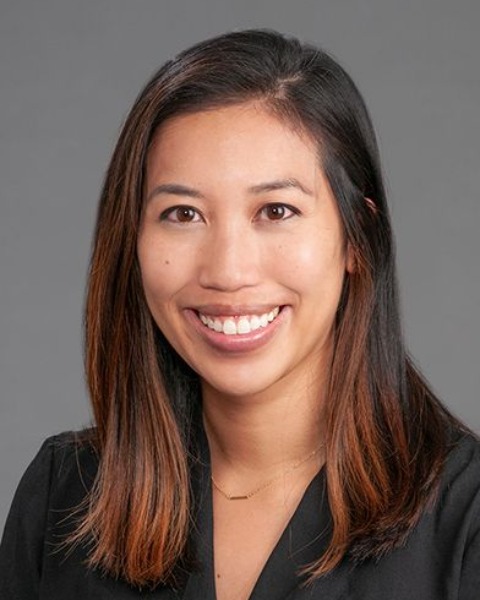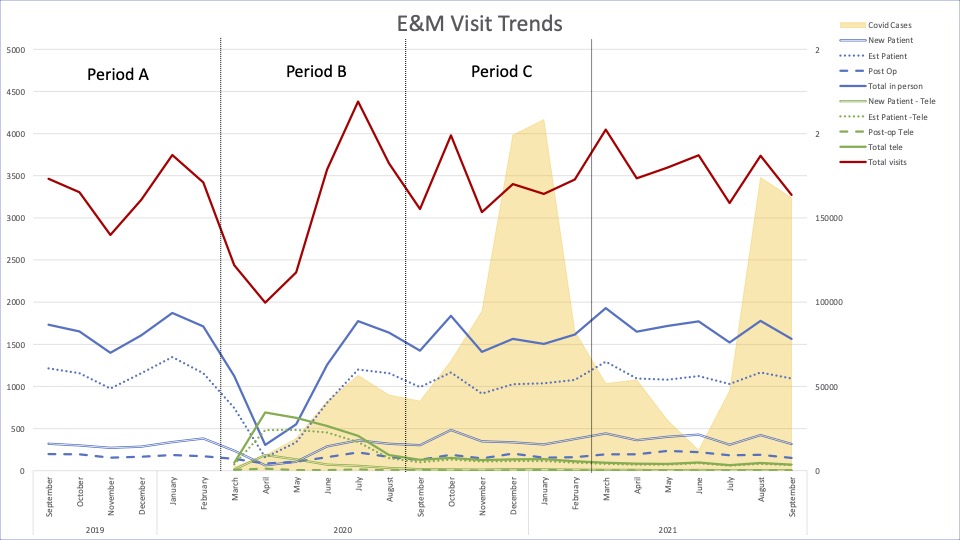Back
Poster, Podium & Video Sessions
Moderated Poster
MP13: Health Services Research: Practice Patterns, Quality of Life and Shared Decision Making I
MP13-14: Impact of COVID and telehealth upon clinic visits by university-based urologists: Implications for access
Friday, May 13, 2022
2:45 PM – 4:00 PM
Location: Room 228
Kim Thai*, Ryan Terlecki, WINSTON-SALEM, NC

Kim H. Thai, MD
Fellow
Wake Forest
Poster Presenter(s)
Introduction: Distancing requirements, supply chain issues, and social anxieties have resulted in restricted clinic interactions and reduced operative volumes. Introduction of telehealth (IOT) allowed access through virtual platforms, with retroactive coverage to March 1, 2020. Data suggests changing attitudes toward work hours, staffing shortages, and varied emotions to telehealth (TH) among patients and providers. We sought to determine trends in volume and complexity of clinical visits per provider for a university-based urology practice.
Methods: The CDC COVID Data Tracker was used to trend COVID cases/month statewide (NC), from the first case (March, 2020) to September, 2021. Outpatient clinic billing data for our practice was drawn for the same interval, as well as the preceding six months, and analyzed within three separate periods: (A) Pre-COVID (9/2019-2/2020), (B) Initial phase (3/2020-8/2020), and (C) First peak (9/2020-3/2021). We extracted E&M codes: 99203-99205, 99213-99215, TH codes 99442-99443, and GT/95 modifiers. 99442 and 99443 were walked over to 99213 and 99214, respectively, as per CMS. Mean monthly visits per provider (MVP) were determined.
Results: From A to B, MVP decreased significantly for in-person (IP) 99203, 99205, 99213 and 99024. However, with IOT, total MVP for 99214 significantly increased (55.5 vs 43.3, p=0.017), and recovered for 99203, 99204, and 99215. Relative to B, C had significantly increased IP MVP for all codes except 99214 and 99024, and TH use decreased significantly for all codes. Relative A, C had significant increases for 99204 (18.0 vs 12.9, p=0.001), 99214 (50.2 vs 43.3, p=0.022), 99215 (14.1 vs 12.5, p=0.024), while 99213 visits did not recover (44.1 vs 50.4, p=0.009); total monthly visits were higher but not significant (p=0.201).
Conclusions: Although in-person visits decreased in the initial phase of the pandemic, clinical volumes recovered during the first COVID peak, with some changes in E&M distribution. The data suggests that IOT allowed improved delivery of care in terms of total visits. Research regarding change in effort distribution is needed. Preservation of TH appears warranted.
Source of Funding: N/A

Methods: The CDC COVID Data Tracker was used to trend COVID cases/month statewide (NC), from the first case (March, 2020) to September, 2021. Outpatient clinic billing data for our practice was drawn for the same interval, as well as the preceding six months, and analyzed within three separate periods: (A) Pre-COVID (9/2019-2/2020), (B) Initial phase (3/2020-8/2020), and (C) First peak (9/2020-3/2021). We extracted E&M codes: 99203-99205, 99213-99215, TH codes 99442-99443, and GT/95 modifiers. 99442 and 99443 were walked over to 99213 and 99214, respectively, as per CMS. Mean monthly visits per provider (MVP) were determined.
Results: From A to B, MVP decreased significantly for in-person (IP) 99203, 99205, 99213 and 99024. However, with IOT, total MVP for 99214 significantly increased (55.5 vs 43.3, p=0.017), and recovered for 99203, 99204, and 99215. Relative to B, C had significantly increased IP MVP for all codes except 99214 and 99024, and TH use decreased significantly for all codes. Relative A, C had significant increases for 99204 (18.0 vs 12.9, p=0.001), 99214 (50.2 vs 43.3, p=0.022), 99215 (14.1 vs 12.5, p=0.024), while 99213 visits did not recover (44.1 vs 50.4, p=0.009); total monthly visits were higher but not significant (p=0.201).
Conclusions: Although in-person visits decreased in the initial phase of the pandemic, clinical volumes recovered during the first COVID peak, with some changes in E&M distribution. The data suggests that IOT allowed improved delivery of care in terms of total visits. Research regarding change in effort distribution is needed. Preservation of TH appears warranted.
Source of Funding: N/A


.jpg)
.jpg)